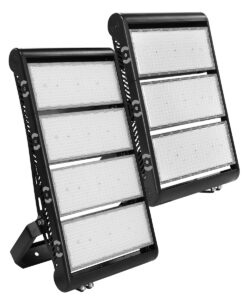In the modern world, lighting affects mood, productivity, safety, and beauty, among other things. The usefulness of spaces is improved by proper illumination, which makes it possible for people to work more comfortably and productively. It also adds to the atmosphere of places, affecting people’s feelings and interactions there. Good illumination makes a big difference in urban safety by lowering accident rates and discouraging criminal activity. Furthermore, by reducing energy usage and carbon footprints, lighting technology innovations like smart lighting systems and energy-efficient LEDs encourage sustainability. Lighting plays a critical role in designing livable, visually pleasing, and environmentally friendly environments.
Choosing between business lights and regular LED lights may appear simple when it comes to lighting commercial environments. Still, there’s more to think about than just the kind of lightbulb. The best lighting solution for your commercial property depends largely on environmental factors. Consequently, it’s critical to get LED commercial light fixtures that are made to endure particular circumstances and offer the ideal illumination for your requirements.
Recognizing the Distinctions
Let’s first define commercial and regular LED lights before delving into the environmental aspects.
Common LED lights: These are primarily made for domestic usage and provide rudimentary lighting options. Although they are available in a range of wattages and color temperatures, their longevity and performance might not be enough for harsh commercial settings.
Commercial LED Lights: Designed for commercial purposes, these LED lights have an optimal light output, can endure extensive use, and frequently come with cutting-edge features like motion sensors, color tweaking, and dimming. They are intended to cater to the distinct lighting requirements of commercial facilities such as warehouses, retail stores, offices, and so on.
There are many different kinds of commercial LED light fixtures, each made to fit particular requirements and uses. Because they provide strong illumination from above, high bay lights are perfect for large places with high ceilings, such as warehouses and industrial facilities.
Troffer lights slot into grid ceilings and provide uniform lighting across wide areas. They are frequently found in business buildings and educational institutions. Panel lights are ideal for retail spaces and medical institutions where bright, uniform lighting is crucial. They provide a sleek, contemporary appearance.
For safety and security, floodlights are utilized in outdoor spaces like parking lots and building facades. They provide wide, bright illumination. Wall packs are used to illuminate perimeters and walkways by mounting them on external walls. Furthermore, linear fixtures provide consistent and energy-efficient lighting solutions and are adaptable enough to be used in a variety of environments, including offices and warehouses. Every kind of LED light fixture for commercial use is made to improve energy efficiency, looks, and usefulness in the space in which it is intended to be used.
Environmental Considerations for Commercial Lighting
The particular environmental conditions of your commercial property will determine whether you choose commercial or regular LED lighting. Take into account the following elements:
Distribution and Intensity of Light
High-Traffic Areas: To maintain safety and visibility, commercial places like lobbies, retail stores, and warehouses need greater light intensity. Commercial lights are usually made to produce the necessary number of lumens.
Task-Oriented Spaces: Offices and industrial environments require a certain distribution of light to facilitate activities like reading, using a computer, or assembling things. To maximize performance, commercial lights frequently include variable beam angles and color temperatures.
Durability and Longevity
Unfavorable Conditions: Lights in commercial settings may be subjected to dust, grime, moisture, and temperature changes. Commercial lights have longer lifespans and are designed to resist these kinds of circumstances, which lowers maintenance costs and downtime.
Regular Use: Commercial spaces are used for longer hours of operation than residential settings. Continuous use is intended for commercial lights without sacrificing performance.
Energy Efficiency
Cost savings: Energy efficiency is crucial because commercial facilities use a lot of energy. Compared to regular LED lights, commercial lights are frequently more energy-efficient, which results in cheaper utility costs and a smaller environmental impact.
Sustainability Objectives: Many companies share the goal of lowering carbon emissions. Purchasing energy-efficient commercial lighting is consistent with eco-friendly endeavors.
Aesthetics and Branding
Brand Image: Lighting can greatly influence the ambiance and impression of a commercial location. To create the ideal atmosphere, commercial lighting provides a greater variety of options for color temperature, light distribution, and design.
Customer Experience: Lighting is a key component of the customer experience in retail and hotel venues. Commercial lighting may improve product presentations, foster a friendly environment, and support a company’s overall identity.
Commercial Areas and Their Requirements for Lighting
Let’s examine some particular commercial areas and the ideal kind of lighting for them:
Offices: Commercial lighting with adjustable color temperature and light distribution is perfect for creating a productive and comfortable work atmosphere.
Commercial Parking: High-intensity, long-lasting lighting is crucial to guarantee security and safety. Motion-sensor-equipped commercial lighting helps optimize energy usage.
Outdoor Parking: To ensure proper visibility and security, high-lumen, weather-resistant commercial lighting is necessary.
Hall Areas: Combining accent and ambient lighting can produce a warm ambiance. Commercial lighting gives you more options for getting the right appearance.
Entrance Canopies: Sleek, well-made lights that withstand the elements improve the curb appeal of the house. Commercial lights offer the required aesthetic appeal and quality.
Conclusion
While some residential applications may be satisfied with standard LED lights, commercial areas require enhanced performance, durability, and energy efficiency. Purchasing commercial lighting that is suited to your unique setting can have a big impact on the atmosphere, staff productivity, customer satisfaction, and cost savings.
You may choose the best lighting system to enhance your commercial property by carefully taking into account elements like light intensity, durability, energy efficiency, and aesthetics.



